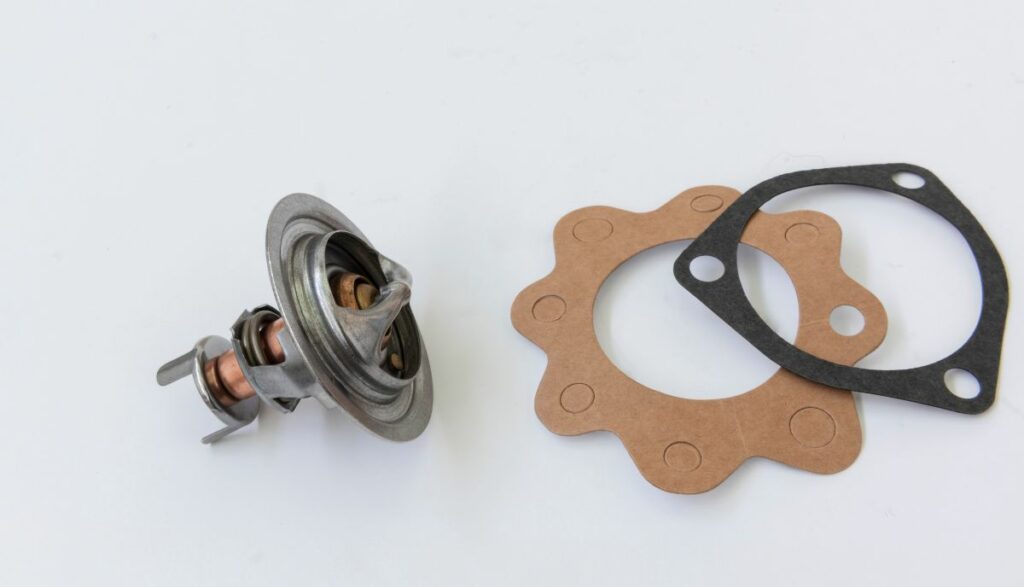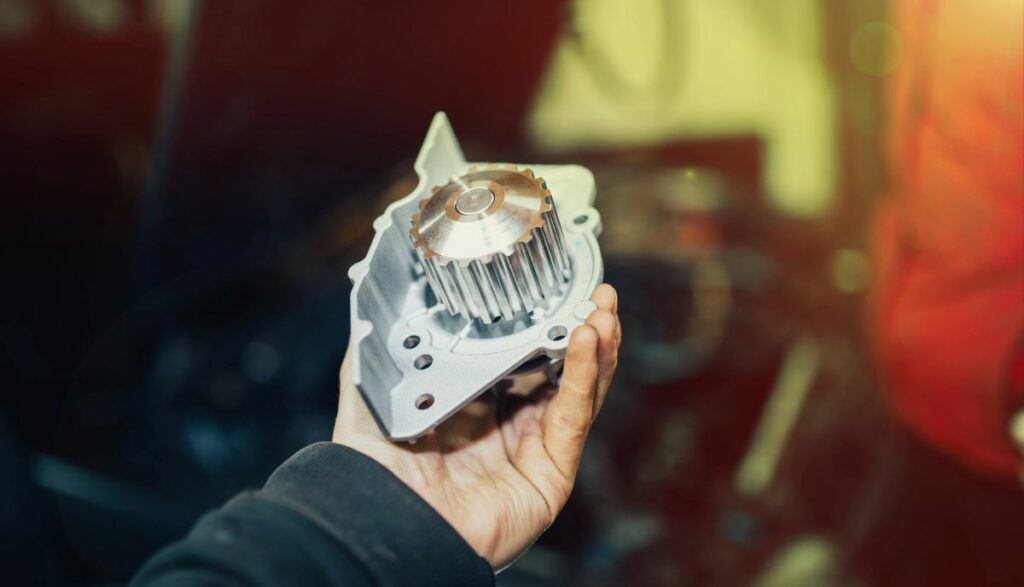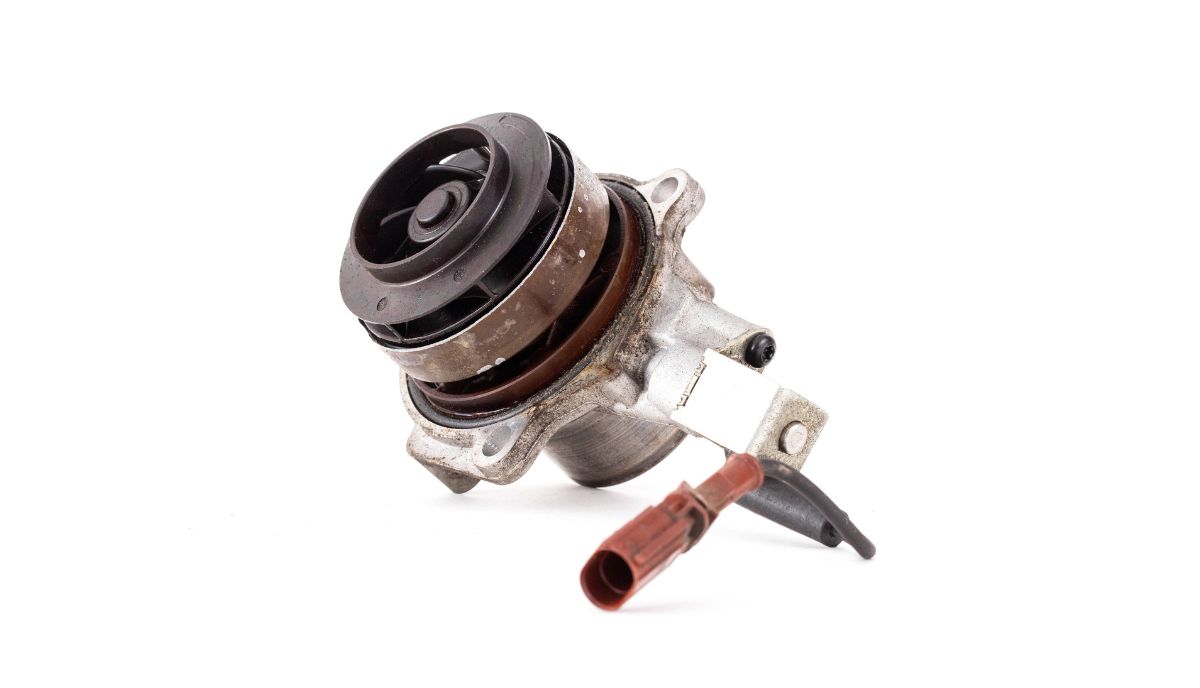The water pump is as essential to the cooling system as the thermostat. Therefore, you would expect a bad thermostat to affect the water pump’s operations? But to what extent? Will the water pump leak once the thermostat fails?
Water pumps will leak before they fail. This is because they have seals that deteriorate and bearings that wobble, eventually allowing the coolant to escape. Other symptoms include:
- High-pitched sounds, such as whining and growling.
- Engine overheating.
- Rust and corrosion on the impeller (because of the leaks).
- Steam emanating from under the hood.
Water pumps can manifest these symptoms for multiple reasons, including a failed thermostat. However, the same signs that reveal a faulty water pump will also appear when the thermostat dies. The only significant exception is the high-pitched noises.
Otherwise, differentiating between a defective water pump and a thermostat is easier said than done. You’re better off taking the vehicle to a professional and asking them to inspect each item individually.
Thermostat Influence On Cooling System

The thermostat and the water pump are part of the same cooling system. As such, their functions are intimately intertwined. A problem in the thermostat is bound to create challenges for the water pump.
How Does The Thermostat Affect Coolant Circulation?
Vehicle engines operate within a 195 – 220 F range. Cold conditions will prevent the oil from flowing and lubricating the engine’s moving parts. The engine may even refuse to start.
On the other hand, temperatures higher than 220 F will wreak the gaskets and seals. The engine will lose power before ultimately failing. The thermostat prevents these outcomes by controlling the coolant flow.
When temperatures get too high, the thermostat will open, allowing the coolant to flow. Once temperatures drop to manageable levels, the thermostat closes, and the coolant stops flowing. In that regard, the thermostat controls coolant circulation directly.
This is why the thermostat’s health is so important. A faulty thermostat can stick open, preventing a cold engine from attaining the temperature required because the coolant keeps flowing and stealing all the heat. A thermostat stuck closed will prevent the coolant from flowing, and the engine will overheat.
Its Role In Maintaining Optimal Engine Temperature
Do you know why cars have cooling systems? This paper in Jurnal Teknologi (Automotive Development Center, University Teknologi, Malaysia) has the answer. Modern engines burn fuel to generate the energy that moves a car.
The burning gas can attain temperatures of 2200 degrees C. While a third of an engine’s power moves the car, another third becomes heat. The cooling system removes that heat.
An efficient cooling system eliminates just enough heat to keep the engine running. After all, removing too much heat will lower the engine’s thermal efficiency, whereas removing too little heat will accelerate the engine’s wear and tear.
Coolant will invade the engine via the bottom hose and leave through the top hose, carrying the heat away. The coolant will run to the radiator to cool down before returning to the engine via the bottom hose.
However, the coolant cannot perform these functions independently. It relies on the water pump to circulate through the engine. The water pump pulls the substance in through the suction side and rotates it with the impeller before sending it to the water jacket.
But again, none of these operations can occur without the thermostat. The water pump cannot circulate the coolant unless the thermostat opens in response to high temperatures. These two components work together to keep the engine within the correct temperature range.
Coolant Flow Disruption Impact:
Because the thermostat is vital to the cooling system’s work, it can damage the engine when it fails and restricts the coolant flow.
How A Bad Thermostat Can Disrupt Coolant Flow?
A thermostat will attract several recognizable symptoms when it fails, including the following:
- The temperature gauge will either fluctuate dramatically or swing into the red.
- The engine will overheat.
- The engine will lose power.
- The fuel efficiency will plummet.
- The ‘Check Engine’ light will illuminate.
These symptoms are not random. They appear because the thermostat has disrupted the coolant flow:
- If the thermostat is stuck closed, the coolant won’t flow. The engine’s temperature will skyrocket because it has no way of ejecting the excess heat.
- If the thermostat is stuck open, the coolant will flow continuously. The engine won’t attain optimal temperatures. It may refuse to start on a cold morning.
You can’t blame the thermostat for every instance where the coolant refuses to flow. Sometimes, the fault lies with the water pump. After all, the water pump circulates the coolant. Even when the thermostat opens, it cannot force the coolant to flow if the water pump is dead.
Therefore, you should focus your troubleshooting efforts on both the thermostat and water pump whenever the coolant stops flowing and the engine overheats.
Potential Consequences For The Water Pump’s Workload
While modern water pumps are robust, they are susceptible to regular wear and tear.Water pump last 60,000 – 90,000 miles. They can fail faster than expected for the following reasons:
- Coolant leaks can cause them to rust.
- You can damage the shaft and bearing by over-tensing the belt.
- This paper in Sage Journals (Henan University of Science and Technology) blames roller and mandrel wear on surface fatigue from large radial deflection loads, which, in turn, can cause the shaft bearing to fail.
- A faulty installation can damage the seals.
- Some people use low-quality seals.
- Bad radiator caps, damaged hoses, and blocked radiators can create low system pressure.
- Coolant leaks can cause the seals to wear out.
- The impeller can sustain damage.
Precluding poor installation, many factors that harm a water pump can originate from a bad thermostat, especially if that thermostat sticks in the closed position. The excess heat will overwhelm the water pump, causing it to seize and fail.
Pressure Changes And Pump Strain
How much strain does a bad thermostat place on the water pump? Can it survive the ordeal? How do pressure changes affect this component?
How Does Irregular Cooling System Pressure Can Affect Components?
You expect the radiator cap to regulate the pressure. It has a valve that provides relief when the pressure climbs to unsafe levels. This is important because overheating from a bad thermostat can increase the pressure, destroying the hoses, radiator, and water pump seal.
Once the hoses rupture, the coolant will leak, exacerbating the high temperatures. The cap is supposed to prevent these disastrous outcomes.
A bad thermostat is unlikely to damage the radiator cap, but you can’t rule it out. A faulty radiator cap can also cause the coolant to leak. This should encourage you to expand your search to the radiator cap whenever you notice a coolant leak, especially if your inspection of the thermostat and water pump has failed to yield results.
Potential Stress On Water Pump Gaskets And Potential For Leaks
You would expect the excess heat an engine generates because of a closed thermostat to harm the water pump, and you would be right. However, you should also consider the impact of low coolant levels on the water pump.
Don’t forget that coolant levels can drop because of overheating due to a bad thermostat. Unfortunately, running a water pump with low coolant levels can expedite its wear and tear. The NAPA Network expects this practice to destroy the seals and bearings because of poor lubrication.
The seals will overheat and fail, allowing even more coolant to leak. Adding more coolant won’t fix them if the seals and bearings have already sustained damage.
Symptoms Of Water Pump Leaks

How can you tell that a water pump is leaking? How do you know the water pump is to blame, not the thermostat?
Identifying Key Signs Indicating A Water Pump Leak
- You can’t confirm anything without visually inspecting the water pump. Look for corrosion on the impeller.
- Check the weep hole and gasket for leaking coolant.
- Check the hoses and radiator for leaks.
- When you park the vehicle, look for puddles on the floor below the water pump’s location.
- A whining or grinding sound will confirm that you have a water pump problem. The noise comes from damaged or misaligned pulleys.
Don’t forget to test the thermostat by placing it in hot water and determining whether it opens. A thermostat stuck closed is easier to fix than a damaged water pump.
Correlation Between Symptoms And Thermostat-Related Issues
A thermostat-related issue will create leaks in the hoses and radiator because of the high temperatures it attracts. Leaking in the water pump’s weep hole, seals, and gaskets sets the water pump apart as the chief culprit.
The same goes for the grinding sound from the bad bearings. You can’t blame the thermostat for defective and noisy bearings. The easiest way to confirm your theories is to test the water pump and the thermostat. The damaged component will fail the test.

